ART INSPIRES at ERNST&YOUNG Zurich
KOSCHKAROW’S SMEARINGS
Text by Jacqueline Burkhard
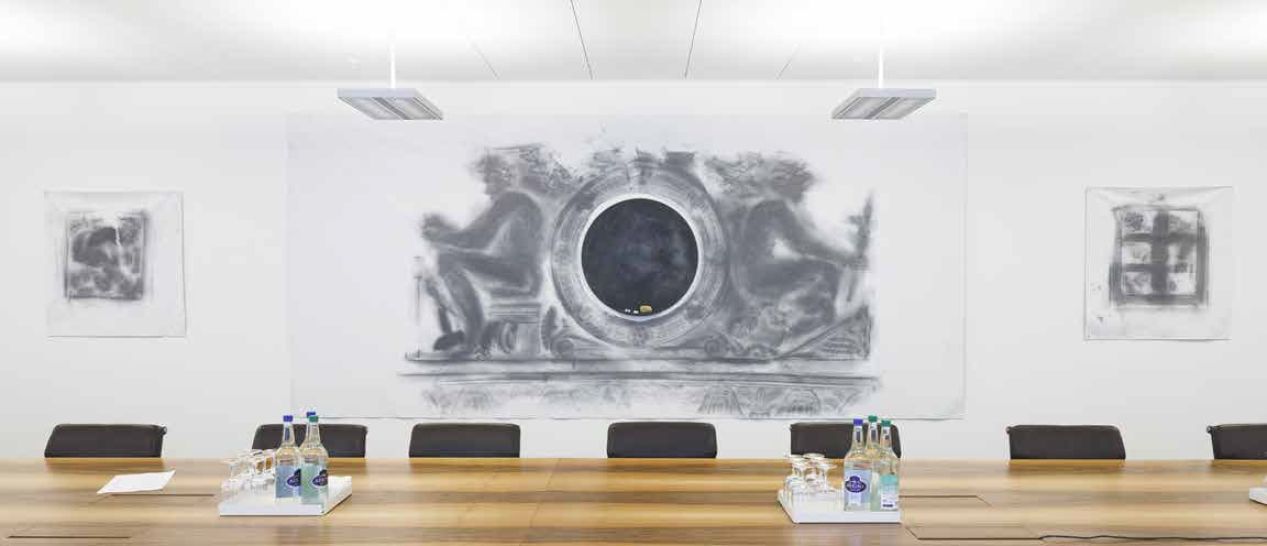
Alexej Koschkarow, Smearings, 2012, Grafit auf grundiertem, synthetischem Textil / graphite on primed synthetic textile, v. l. n r. Einbrecher, 104 x 100 cm, Hephaistos und Merkur, 208 x 462 cm, Gefangener,
100 x 95 cm l-r: Burglar, 40.9 x 39.3”, Hephaestus and Mercury, 81.8 x 181.8”, Prisoner, 39.3 x 37.4”.
Im grössten Sitzungszimmer des EY-Gebäudes – sein Name ist «Zürich» – hängt an der Längswand ein dreiteiliges Kunstwerk, ohne Rahmen, direkt an die Wand fixiert. Es ist ein Ensemble von drei sogenannten «Smearings» von Alexej Koschkarow, das viele kulturelle Anspielungen in sich trägt, unter anderem solche, die auf die Geschichte von Firmensymbolen und deren Herkunft verweisen. «Smearing» (Schmiererei) ist eine Wortschöpfung des Künstlers, der damit sein Abriebverfahren von Reliefs mit Grafit auf Textil bezeichnet. Im Wesentlichen entspricht es der Frottagetechnik, die bei den Surrealisten und insbesondere bei Max Ernst beliebt war.
Im grossen, mittleren Smearing sind zwei athletische, allegorische Männerakte mit ihren Attributen zu sehen: rechts ein Merkur, Symbolfigur des weltweiten Handels, den Heroldsstab haltend, links ein Hephaistos des Maschinenzeitalters, Allegorie des Handwerks und der Industrie, mit den Attributen Vorschlaghammer und Zahnrad. Heraldisch komponiert, sitzen die beiden Figuren symmetrisch voneinander abgewandt, getrennt durch eine runde, in die Textilfläche eingelassene Wandtafel, an der unten ein kleines Brettsegment zur Ablage von Kreide und Schwamm angebracht ist.
Das grosse Smearing ist von zwei kleineren flankiert, links von der Darstellung eines Einbrechers mit Schildmütze, Handleuchte und Revolver, rechts vom Bild eines hinter Gittern sitzenden Gefangenen.
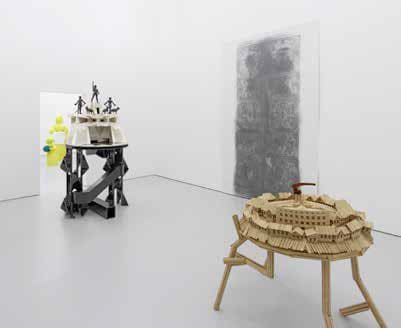
In the EY Building, an unframed work of art has been mounted directly on the long wall of the largest conference room, named “Zürich.” It is an ensemble of three works by Alexej Koschkarow and rich in cultural allusion, including the history of corporate symbols and their origins. The artist calls them “Smearings,” a term he coined to describe the rubbings he makes of reliefs using graphite on textiles. The Smearings are comparable to frottage, a technique cultivated by the Surrealists and especially favored by Max Ernst.
The large work in the middle pictures two athletic, allegorical male nudes, each with their attributes: seated to the right, Mercury, symbolic figure of worldwide trade, is shown holding his herald’s staff, and to the left, Hephaestus of the machine age with sledgehammer and gears, symbolizing craftsmanship and industry. The heraldic composition shows the two figures placed symmetrically back to back, with a round black board set into the fabric between them, at the bottom of which a small bit of wood provides a shelf for chalk and sponge.
This large Smearing is flanked by two smaller ones: to the left a thief with a cap, torch and revolver; to the right a prisoner sitting behind bars.
Alexej Koschkarow, born in Belarus in 1972, trained at the Art Academy in Minsk, where he acquired a solid, classical background in the crafts of drawing, composition, oils, murals, and especially monumental paintings. The latter attests to the fact that the tradition of producing gigantic pictures, in the political propaganda style of Socialist Realism, was still cultivated after the collapse of the Soviet Union. Following his graduation in Minsk, Koschkarow attended the renowned Art Academy in Düsseldorf, studying sculpture with Fritz Schwegler, whose students include such renowned international artists as Katharina Fritsch and Thomas Schütte. Schwegler also signed Koschkarow’s diploma in 1999.
Subsequently the artist continued to work in a variety of media, including drawing, painting, and making pottery. The video recording of his notorious performance of a pie fight, staged in 2001, has been acquired by such museums as the Kunsthaus Zürich. However, his core medium has always been sculpture. He began doing Smearings in 2012, the same year that the EY acquired the ensemble for their conference room.
Alexej Koschkarow, 1972 in Weissrussland geboren, bildete sich zuerst in der Kunstakademie Minsk zum klassischen Allrounder mit solidem handwerklichem und technischem Wissen in den Fächern Zeichnen, Komposition, Öl-, Wand- und insbesondere auch Monumentalmalerei aus. Letzteres bezeugt, dass die Tradition der Produktion von gigantischen Bildern, die vor der Wende – noch dem Stile des Sozialistischen Realismus verpflichtet – im Dienst der Politpropaganda stand, auch nach dem Fall der Sowjetunion noch wirksam weitergeführt wurde. Nach seinem Abschluss in Minsk zog es Koschkarow an die renommierte Düsseldorfer Kunstakademie zu Fritz Schwegler, dem Professor für Skulptur, der weltweit bekannte Künstlerinnen und Künstler wie Katharina Fritsch oder Thomas Schütte ausgebildet hatte. 1999 unterzeichnete er auch Koschkarows Diplom.
In der Folge drückt sich dieser weiterhin in verschiedenen Medien aus, zeichnet und malt, arbeitet in Keramik und inszeniert 2001 als Performance eine berühmte Tortenschlacht, deren Videoaufzeichnung in die Sammlung von Museen wie dem Kunsthaus Zürich Eingang findet. Im Zentrum seines Wirkens steht jedoch die Skulptur. Die Smearings bilden eine Werkgruppe, die er 2012 begann, in ebendem Jahr, in dem EY das Ensemble für den Sitzungsraum erwarb.
Charakteristisch für Koschkarows Arbeitsmethode ist, dass er keinen Aufwand scheut, weder bei der allmählichen Formfindung noch bei der Ausführung seiner Arbeiten, die zuweilen zu umfangreichen stimmigen Installationen anwachsen.
Voller Elan und detailbesessen führt er eigenhändig aus, was nicht zwingend das Fachwissen eines Spezialisten und entsprechende Geräte benötigt. So verwandelte er 2002 eine Kölner Galerie in eine barockisierende Bibliothek mit Kassettendecke und Steinboden in Holz- und Marmorimitation. Man betrat den Raum paradoxerweise durch ein grosses Cheminée und traf innen auf vollgestopfte Wandregale mit fingiert vergilbten und gebündelten Akten, zwischen denen auch mal ein Totenkopf auftauchte und als Vanitas-Symbol die verronnenen Ereignisse erahnen liess, von denen die Akten hätten handeln können.
Nach mehreren Museums- und Galerieausstellungen im Verlauf der letzten Jahre überraschte er im Sommer 2016 erneut mit einer suggestiven Installation im Schaulager in Münchenstein (Basel), die er gemeinsam mit der Künstlerin Katharina Fritsch konzipiert hatte.
Sie trug den Titel Zita – Щара (Schtschara), «Zita» als Anspielung auf die letzte Habsburger Kaiserin und «Schtschara» nach dem Namen des Flusses in Weissrussland, wo Koschkarows Urgrossvater im Ersten Weltkrieg an der Front im Kampf gegen die Deutschen verletzt wurde.
Fritsch und er nannten die Ausstellung «Ein Kammerstück»; sie war klein, aber inhaltlich hochgradig aufgeladen, denn sie widmete sich der Stimmung zur Zeit des Ersten Weltkriegs, einer Zeit des Grauens, aber auch der hochproduktiven Innovationen in der Kunst, als sich die umwälzenden Konzepte der Moderne, des Expressionismus, Futurismus, Kubimus, Dadaismus und Suprematismus entwickelten.
Nach einigen Jahren in Düsseldorf und Berlin übersiedelte Koschkarow 2011 in die USA. Heute lebt er in Brooklyn. Sein Atelier hat er in einer ehemaligen Hutfabrik chassidischer Juden eingerichtet, in einer historisch und soziologisch stimulierenden Gegend unweit des East River, in der noch die Atmosphäre von Hafenspelunken, Warenlagern und Kleinindustrien herrscht, an das aber auch ein Villenviertel grenzt, das einst von gut betuchten Hugenotten und eingewanderten Handelsleuten aufgebaut wurde.
Koschkarow ist ein Grossstadtflaneur erster Güte. Mit ihm durch Brooklyns und Manhattans reizüberflutete Strassen streifend, erfährt man, mit welch schnellem Auge und geübtem Wahrnehmungssinn, mit wie viel Neugier, Belesenheit und Verständnis er die Zeichen der Alltagsszenerien und historische Spuren dechiffriert und selbst aus den Augenwinkeln unauffällig Spannendes wahrnimmt. Auf unseren Spaziergängen klärte er mich über die Bedingungen der historischen Einwanderer auf und über die damit verbundenen urbanistischen Entwicklungen und architektonischen Stileinflüsse. Indikatoren dieser Geschichte sind Dekors und Reliefs an historischen Bauten, die Koschkarow aufgreift, um sie in seiner Kunst zu reflektieren und umzuwandeln. Für das Anfertigen seiner Smearings sieht man ihn gelegentlich als Fassadenkletterer in halsbrecherischer Höhe Reliefs abreiben. So geschah es auch für das Ensemble im Sitzungszimmer Zürich.
Das Relief für das grosse Smearing entdeckte er in Manhattan über dem Eckportal des Gebäudes der ehemaligen Jarmulowsky Bank, an der Kreuzung Canal Street / Orchard Street. Selbstverständlich sind an der originalen Steinskulptur die Einzelheiten wesentlich deutlicher erkennbar als auf dem Smearing. Merkur sitzt auf einem Löwenfell, das über ein Fass geworfen ist. Zu seinen Füssen liegt ein Anker mit Kette, angelehnt an aufgerolltes Tauwerk. Der Heroldsstab ist von Flügeln gekrönt und von zwei Schlangen umwunden. Ein Zaun und eine Seelandschaft mit Segelschiff bilden den Hintergrund. Sie fehlen im Smearing ebenso wie die architektonischen Motive im Hintergrund des Hephaistos. Erst vor dem originalen Relief lässt sich auch erahnen, dass in dem runden Loch, wo im Smearing die Tafel eingefügt ist, einst eine heute verlorene Uhr eingelassen war, deren Umrahmung oben ein kleiner Merkurkopf mit Flügelhelm und Lorbeerzweigen krönt.
Für seine Smearings spannt Koschkarow ein leicht elastisches, vorgrundiertes Textil über das Relief, um darauf mit Grafit den Abrieb zu vollziehen. Anders jedoch als bei dokumentarischen Abrieben von Skulpturen, Münzen oder Metallgravuren, für die sich zu Zeiten vor der Fotografie vor allem Kulturwissenschaftler und Sammler interessierten und in denen alle Einzelheiten zwingend lesbar sein mussten, entscheidet Koschkarow nach künstlerischen Kriterien, was mit welchem Effekt auf den Smearings erscheinen soll. Nicht Detailtreue, sondern Expressivität und malerische Qualität sind ihm wichtig, der Strich folgt seinen Impulsen. Er benutzt das historische Relief als Readymade, vollzieht aber dessen Transformation in ein entgegengesetztes Medium, das inhaltlich neu und vielschichtig belebt wird, physisch voller Leichtigkeit ist und sich im Ausdruck von der Skulptur gänzlich unterscheidet.
Den Smearings im Massstab 1:1 haftet etwas Auratisches, wenn nicht gar Gespenstisches an. Sie tragen die unmittelbaren Spuren der direkten Berührung mit dem geschichtsträchtigen Objekt in sich. Die Abriebe sind, wie fotografische Negative, voller anziehender Befremdlichkeit: Je stärker die Erhebungen in der Skulptur im Licht stehen, desto dunkler treten sie in der Grafitwolke des Smearing hervor – als wolle der Künstler die unergründliche Nachtseite der Reliefs in die Gegenwart holen.
Die Inschrift am Gebäude über den Allegorien hat Koschkarow nicht in seine Arbeit aufgenommen: «S. Jarmulowsky’s Bank Est 1873».
Hinter dem Namen steht die Person Sender Jarmulowsky (1841–1912), Auftraggeber für Gebäude und Relief. Als polnisch-jüdisches Waisenkind wuchs er in der Familie eines Rabbiners in Grajewo auf, heiratete die Tochter eines reichen Handelsmanns und baute als junger Geschäftsmann in Hamburg ein transatlantisches Schifffahrtsunternehmen für Reisende und Waren auf. 1873 emigrierte er mit seiner Familie nach New York, um dort die Bank zu gründen, die zu einer der erfolgreichsten der Stadt wurde. Der American Dream hatte sich erfüllt.
Die Werbung der Jarmulowsky Bank zielte damals vor allem auf jüdische Einwanderer, damit sie bei der Bank billige Tickets für die Überfahrt aus Europa auf den bankeigenen Schiffen kauften, Konten eröffneten oder Kredite aufnähmen. Kurz vor seinem Tod, 1912, konnte Sender Jarmulowsky gerade noch den 12-stöckigen Neubau der Bank mit dem Relief einweihen. Trickreich liess er dank eines kleinen, heute abgetragenen Kuppelpavillons auf dem Dach das Gebäude zum damals höchsten der Lower East Side werden. Zu Beginn des Ersten Weltkriegs geriet die von Jarmulowskys Söhnen geführte Bank in Schieflage und musste 1917 Insolvenz erklären. Seither wechselte das Gebäude mehrmals seine Nutzung, heute steht es unter Denkmalschutz und soll demnächst zu einem Geschäftshaus umfunktioniert sein.
Die griechischen Götter als Allegorien auf dem Relief über dem Eingangsportal verweisen auf Sender Jarmulowskys Ambition, die Wurzeln seiner Bank bis in die blühenden Zeiten der europäischen Kultur zurückzuführen und die Antikensehnsucht mit dem Maschinenglauben zu paaren, wovon vor allem das Hephaistos zugeordnete Zahnrad zeugt.
Der Bildhauer des Reliefs, dessen Namen noch ausfindig zu machen bleibt, orientierte sich für die Komposition auch an Michelangelos sogenannten Ignudi, den zwanzig idealen männlichen Akten mit ihren reich variierenden Positionen an der Decke der Sixtinischen Kapelle, die dort jedoch einander zugewandt sitzen.
Koschkarow’s approach is characterized by unremitting devotion to the gradual process of invention and to the execution of his works, which may burgeon into elaborate, cogent installations. He is a devil for detail and with indefatigable energy executes everything himself that can be done without specialized skills or corresponding equipment. In 2002, for instance, he transformed a gallery in Cologne into a Baroque library with a coffered ceiling and stone floor in imitation wood and marble. Visitors paradoxically had to duck through a large fireplace to enter a room full of shelves that were crowded with yellowed bundles of fake files, a skull cropping up occasionally between them as a Vanitas symbol of the remote events potentially contained in the documents.
After several exhibitions in museums and galleries in recent years, he came up with another surprise in the summer of 2016, creating a highly suggestive sculpture for the Schaulager in Münchenstein (Basel), conceived in collaboration with the artist Katharina Fritsch. The show was titled Zita – Щара (Shchara): Zita refers to the last Empress of Austria, and Shchara to the name of the Belarusian River where Koschkarow’s great-grandfather was wounded at the Front in the First World War. He and Fritsch subtitled the exhibition “A Chamber Piece.” Though modest in size, it was intensely charged, and indeed explosive, evoking the mood of the First World War, a time not only of unadulterated horror but also of extraordinarily productive innovation in the arts, for it was then that the revolutionary concepts of modernism took shape in Expressionism, Futurism, Cubism, Dada, and Suprematism.
After a few years in Düsseldorf and Berlin, Koschkarow settled down in the United States in 2011. He lives in Brooklyn where he set up a studio in what was once a hat factory operated by Hasidic Jews. The historically and sociologically stimulating neighborhood is located not far from the East River. Still dominated by the atmosphere of sailors’ alehouses, warehouses and small industry, it borders on a neighborhood of mansions once built by well-heeled Huguenots and immigrant merchants.
Koschkarow is an urban flaneur of the first order. Roaming with him through the stimulus-overkill streets of Brooklyn and Manhattan, you realize how quickly and astutely he takes in his surroundings; you note how curious, well read, and knowledgeable he is and how perceptive in reading the signs of ordinary scenarios, specifically decoding historical traces and more often than not, espying inconspicuous moments of excitement from the corner of his eyes. During our walks together, he explained to me the circumstances of historical immigration that led to urban development and architectural influences on style. Indicators of this background are the decoration and reliefs found on historical buildings. Koschkarow incorporates, transforms, and reinterprets these in his work. When creating his Smearings, it is not unusual to encounter him clinging to façades at daredevil heights in order to make rubbings of reliefs. The ensemble for the conference room Zürich is no exception.
Koschkarow discovered the relief for the large, centered Smearing in Manhattan above the corner entrance to the former Jarmulowsky’s Bank on the intersection of Canal Street and Orchard Street. The details of the original stone sculpture can, of course, be more easily distinguished in the original than in the Smearing. Mercury is sitting on the pelt of a lion that has been tossed over a vat. Lying at his feet are anchor and chain, propped against coiled rope. Snakes are twined around the herald’s staff, which is crowned with wings. A fence and a seascape with a sailing ship are seen in the background. They are missing in the Smearing as are the architectural motifs in the background of Hephaestus. Moreover, only by looking at the original relief does one realize that there was once a clock in the round hole that now contains the blackboard in the Zürich conference room, and that the frame around the clock was crowned with a small head of Mercury wearing a winged helmet and embellished with laurel branches.
To make his Smearings, Koschkarow applies graphite to primed, slightly elastic textile pulled taut over the relief. Documentary rubbings of sculptures, coins or metal engravings aim to achieve maximum legibility and were of particular interest to scientists and collectors prior to the age of photography. In contrast, Koschkarow is motivated by artistic criteria when deciding what should appear on the Smearing and to what effect. Rather than being faithful to detail, he is interested in the expressive potential and painterly qualities of his images, making strokes that follow his impulses. He treats the historical relief as a readymade, but transforms it into a diametrically opposed medium, animating it with new content and complexity, suffusing it with lightness and lending it an entirely different expression from that of the sculpture. There is something auratic and even spectral about Koschkarow’s full-scale Smearings. They bear unmistakable traces of immediate contact with the historically charged object. Like photographic negatives, the rubbings are imbued with a curiously appealing estrangement: the lighter the raised portions of the reliefs, the darker they become in the graphite cloud of the Smearing— as if the artist were foregrounding the unfathomable nocturnal side of the relief.
Koschkarow has not incorporated into his work the inscription placed above the allegorical figures on the building: “S. Jarmulowsky’s Bank Est 1873.” It refers to the man who commissioned the building and the relief: Sender Jarmulowsky (1841–1912). Of Polish Jewish origin, the orphan grew up with the family of a Rabbi in Grajewo, married the daughter of a wealthy merchant and, as a young businessman in Hamburg, built up a transatlantic shipping company that transported travelers and goods. In 1873, he and his family emigrated to New York, where he established a bank that was to become one of the most successful in the city. He had fulfilled the American Dream. His bank largely attracted Jewish immigrants by offering them inexpensive passage for the voyage from Europe on the bank’s own ships and enabling them to open accounts with the bank and take up loans. Sender Jarmulowsky had just managed to inaugurate the new 12-story building with the relief when he passed away in 1912. He had cleverly succeeded in making it the tallest building in the Lower East Side by adding a domed pavilion to the roof of the bank, which has since been removed. At the beginning of the First World War, Jarmulowsky’s sons, now in charge of the bank, suffered severe setbacks and the bank had to declare insolvency in 1917. The use of the building has since changed several times and has now become a landmark site, scheduled soon to be converted into an office building.
The Greek gods on the relief above the entrance allegorically represent Sender Jarmulowsky’s wish to demonstrate that his bank was rooted in the heritage of a flourishing European culture. Furthermore, by picturing gears as an attribute of Hephaestus, they unite an allusion to antiquity with faith in machines. The as yet unidentified sculptor of the relief based his composition on Michelangelo’s so-called Ignudi, 10 pairs of idealized male nudes, here, by contrast, shown facing each other in richly nuanced positions on the ceiling of the Sistine Chapel.
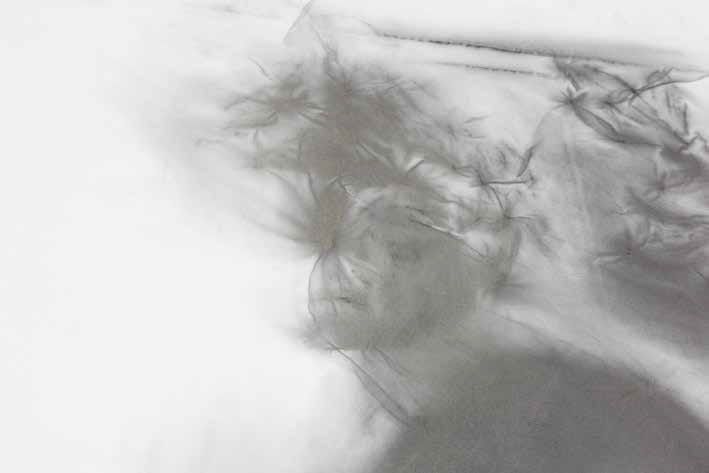
Die Reliefvorlagen der beiden kleineren, flankierenden Smearings hat Koschkarow in Brooklyn an der Fassade der 1927–29 erbauten Williamsburgh Savings Bank, One Hanson Place, entdeckt, einem Artdéco-Bau und Flagschiff der Brooklyner Finanzwelt, der mit seinen 156 Metern einst das höchste Bauwerk Brooklyns war. Es handelt sich um Pendants, passende Gegenstücke. Im linken Bild erscheint der grobschlächtige Einbrecher «auf der Pirsch» samt Taschenlampe, Revolver und Rucksack voller Einbruchwerkzeug, auf dem rechten sitzt ein Gefangener hinter Gittern auf einer Bank seine Strafe ab, den Kopf gelangweilt in die Rechte gestützt. Es handelt sich gewissermassen um ein und dieselbe Figur, dargestellt in zwei Szenen.
Die beiden harten Kerls zeigen sich in ihrer Kleidung als Kriminelle aus dem frühen 20. Jahrhundert und sind hier – im Kontrast zu den Idealfiguren Merkur und Hephaistos – apotropäische, das heisst hässliche, Unheil abwehrende Gestalten, ähnlich den monströsen Wasserspeiern und anderen Ungetümen an romanischen und gotischen Kirchen, die das Böse darstellen, um es zu bannen. Mit ihnen wollte die Savings Bank deklarieren, dass ein Einbrecher bei ihnen keine Chance hätte und unweigerlich im Kittchen landen würde. Dabei wirken sie mit ihrer mühselig gedrungenen Haltung, eingeklemmt in den engen kubischen Raum, auch wie humoristische Schattenfiguren.
Beim Auswählen der Smearings in Koschkarows Brooklyner Atelier galt es sorgfältig zu erwägen, welche Sujets und Formate am besten zu EY und in den Sitzungsraum Zürich passen und an diesem Standort wirksam zu Assoziationen und Einfällen stimulieren könnten. Die Entscheidung für das zweifache Männerduo, die edlen Allegorien und die gebannten Kriminellen, schien naheliegend, besteht der Name der Firma doch auch aus den Anfangsbuchstaben zweier Persönlichkeiten, die sich in ihrem Leben nie begegnet sind und deren Firmen erst 1989 fusionierten, woraus letztlich die heutige EY hervorgegangen ist: des Amerikaners Alwin C. Ernst (1881–1948) und des Schotten Arthur Young (1862–1948).
Koschkarow discovered the source reliefs for the smaller Smearings on the façade of Williamsburgh Savings Bank, 1 Hanson Place, an Art Deco building and flagship location of the financial world in Brooklyn. It rises 512 feet and was once the tallest building in Brooklyn. Flanking the larger image, the two reliefs form a cautionary pair: to the left, a coarse, low-bred thief “casing the joint” with torch, revolver, and a knapsack full of burglary tools; to the right, a bored prisoner doing time behind bars, his head listlessly resting on his right hand. It is basically the same figure, represented in two different scenes.
The clothing of the two ruffians identifies them as criminals from the early 20th century and in contrast to the idealized figures of Mercury and Hephaestus, they are ugly, apotropaic figures, that is, designed to ward off evil much like the monstrous gargoyles and other creatures on Romanesque and Gothic churches, which represent evil in order to ban it. The bank was making a statement: thieves don’t stand a chance and will inevitably land in the clink. Laboriously doubled up, squeezed into their small square space, the two figures also look somewhat like humorous, cartoon silhouettes.
The Smearings were selected in Koschkarow’s Brooklyn studio after carefully evaluating which subject matter and format would best suit EY and the Zürich conference room, and would also most effectively stimulate associations and ideas in this location. The choice of two sets of paired men, noble allegories and banned criminals, seemed appropriate inasmuch as the company is named after two entrepreneurs who never met one another and whose companies did not merge until 1989. EY, as the company is now called, stands for the first letter of their last names: Alwin C. Ernst (1881–1948) from North America, Arthur Young (1862–1948) from Scotland.
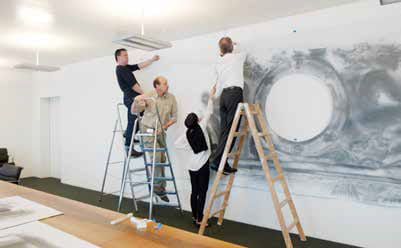
Am Tag der Hängung der drei Smearings, im April 2013, schrieb Alexej Koschkarow denn auch «E & Y» auf die schwarze Tafel. Und es ist sein ausdrücklicher Wunsch, dass jede Person, die Lust hat, etwas mitzuteilen, diese reizvolle archaische Methode nutzt, zum Schwamm greift, auswischt, was da in Kreide steht, und einen neuen Spruch, oder was immer zur Sitzung passt, auf die Tafel schreibt oder zeichnet. Den dunklen Spannteppich unter der Wandtafel wollte Koschkarow zunächst halbrund abschaben, um so den Eindruck zu erwecken, die Tafel hänge schon lange hier und unzählige Leute hätten bereits davorgestanden. Diese Inszenierung hätte dem Ensemble verstärkt den Charakter einer Rauminstallation verliehen, doch wurde entschieden, den Teppich künstlerisch unbearbeitet zu lassen, auf dass sich der Effekt mit der Zeit von selbst einstellen kann.
Schwarz auf weiss hat Koschkarow ein kommunikatives, interaktives Werk geschaffen, auf welches jeder, dem es beliebt, gedanklich oder handfest weiss auf schwarz reagieren kann. Wer mitspielt, wird Teil der Installation, wird zur fünften Person im Werk, vollzieht bewusst oder nicht einen performativen Akt und erfüllt den Wunsch dieses ebenso universellen wie unpathetischen Künstlers, sein Publikum frei mit einzubeziehen.
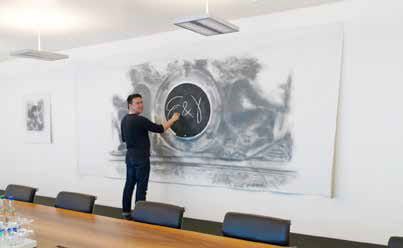
On the day the three Smearings were mounted in April 2013, Alexej Koschkarow picked up a piece of chalk and wrote “E & Y” on the blackboard. It is his explicit wish that anyone who feels like communicating something make use of this appealing archaic method of sponging off whatever is on the blackboard and writing a new comment, sketch, or anything else that might be connected to the respective situation. Initially, Koschkarow wanted to scrape a semicircle onto the carpet underneath the blackboard to generate the impression that it had been hanging there for so long that it bore traces of the countless people who had already stood there to write something. This would have underscored the character of the ensemble as an installation but the decision was then made not to intervene artistically, instead allowing time to produce the same effect on its own.
Koschkarow has created a communicative, interactive work, black on white, to which anyone can choose to react mentally or physically, white on black. Those who do choose to make a contribution become part of the installation. Through their conscious or unconscious performative act, they become the fifth person in the work and fulfill the wish of this equally universal and down-to-earth artist: to give his audience complete freedom in committing to his work.